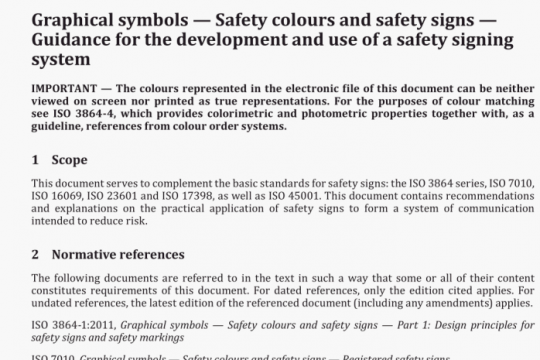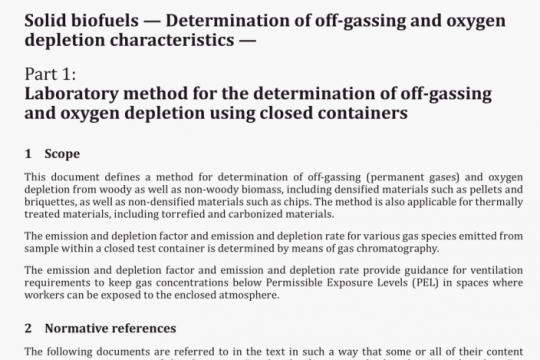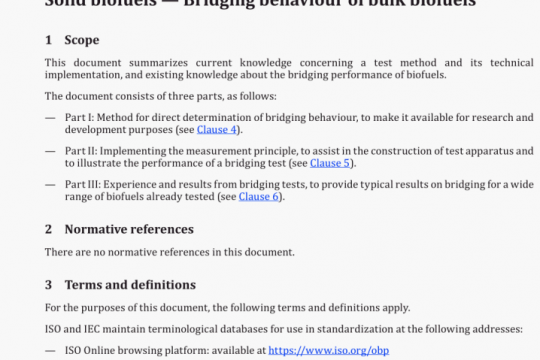ISO 21820 pdf free download
ISO 21820-2021 pdf free download.Fine ceramics (advanced ceramics, advanced technical ceramics) – Ultraviolet photoluminescence image test method for analysing polytypes of boron- and nitrogen-doped SiC crystals.
S Principle
When UV light illuminates a material having DAP recombination energy in the visible-light range, the material will emit a specific colour depending on the DAP recombination energy. Thus, the polytypes of SiC can be identified by their luminescence colour because different SiC polytypes have their own DAP recombination energy. The polytype area in CIE 1931 colour space is mapped and transformed from the UVPL image; subsequently, the polytype ratios are calculated.
6 Apparatus
6.1 Stage. The experiment should be performed in a non-vibrational state or on an anti-vibration table to prevent noise caused by vibration.
6.2 Digital camera, This should be a charge-coupled device (CCD) camera with an ISO rating of
(500 ± 100), (tj#) of tjl,8-f/3,2 and zero exposure compensation. The shutter speed should be 1/30
to 1/50 and the white balance should be 6 500 K. These are the standard conditions for the UVPL image
test, but they can be varied.
The purpose and function of a CCD camera is to produce an image similar to the object recognized by the human eye. This is achieved by synthesizing the image consisting of the artificial fine shapes and colours. It should be noted that the CCD camera is neither a spectra analyser nor a spectra recorder.
Before evaluating the polytype, the CCD camera should be calibrated. The LJVPL image captured by the CCD camera should be significantly expanded and carefully checked. II any artificial pattern is observed, the CCD camera should be replaced with another.
6.3 Lens. This is used to focus the incident UV beam onto the specimens. The position and focal length of the lens should be selected for the beam to spread over every sample with uniform intensity.
6.4 Light source. The wavelength (A) of the UV light source (UVLS) should be 180 nm to 365 nm in the nonvisible range and monochromatic range. The intensity of the light source should be 600 mW/ cm2 or above. The working distance between the sample and the light source should be approximately (10—.30) cm. In reflectance mode, adjust the angle (0-.360)° between the direction of the light source and the direction normal to the sample to prevent the UV source from being incident directly on the CCD camera and measure only the luminescence beam. In transmission mode, the luminescence beam produced by the sample should be measured using the CCD camera after having been transmitted through the sample.
6.5 Filter. tJVLSs can emit a visible beam as well as a UV beam. If the visible beam is incident on the CCD camera, it can disturb the data measurements. Therefore, a bandpass filter that passes only tJV beams should be positioned in front of the tJVLS.
7 Sampling
7.1 i’he UVl’L technique can be applied to SIC samples grown by various techniques. l’he necessary condition Is to have boron and nitrogen dopant at concentrations that are sufficient to emit the luminescence of the DA pair at an effectively high intensity.
7.2 The flat surface of a sample should be polished finely to improve the measurement accuracy by preventing the UV beam from being scattered for the beam to remain incident directly on the digital camera.
7.3 Should there be any treatment (e.g. polishing) before the test, it shall be recorded in the test report.
8 Procedure
8.1 Cleaning of SiC wafer surface
The samples should be handled in a clean environment, such as a clean-booth or clean-room. The clean surface of a wafer should be maintained. Wiping with a soft tissue soaked with a volatile solvent, such as acetone or ethanol, can render the sample surface free of foreign contaminations, such as dust, other particles, metals, organic compounds, inorganic compounds or moisture. However, if the surface contamination remains and thereby influences the measurements, the sample surface should be wet cleaned in a clean environment, using ultra-high-purity water and chemicals, such as H2S04: H202: H20, NH4OH: H202: H20, HCI: H202: H20 or other suitable chemicals.
Figure 1 shows examples of polytype shapes. ‘T’pically, they have clear and sharp lines revealing the grain boundaries.ISO 21820 pdf free download.




